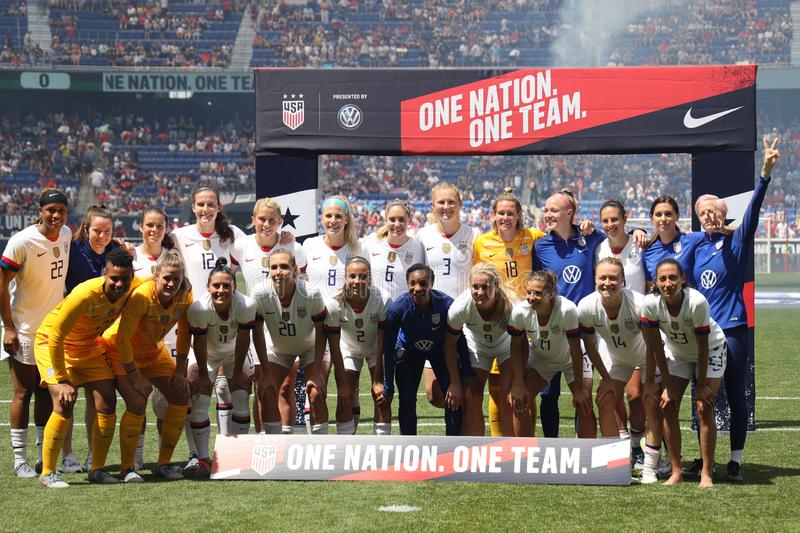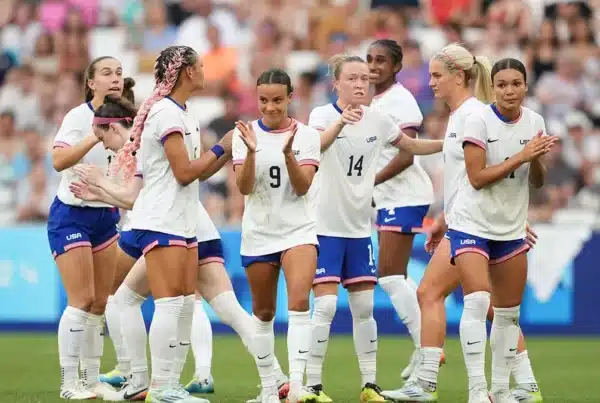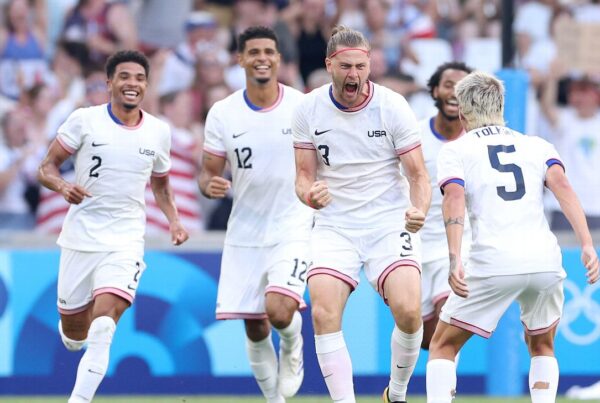
The Radical Genius of the USWNT’s Equal Pay Deal
After a yearslong battle that involved a wage discrimination complaint, a federal lawsuit, and initial failed negotiations with the U.S. Soccer Federation, the U.S. Women’s National Team has finally secured equal pay with the men’s team in a new collective bargaining agreement. This is a historic achievement for the leaders of the women’s team, for whom victory was not at all guaranteed, and who seem rightfully pleased and proud about the deal.
In recent years, the pay dispute has been the source of significant division and ugly recriminations among the three parties (U.S. Soccer, the USWNT, and the USMNT) and the teams’ respective fans. One of the biggest sticking points in the negotiations was the issue of World Cup prize money. Many believed that the pay gap in the pools of money available to qualifying teams—a difference of about $380 million for the next World Cup cycle—was too large to be bridged, especially since FIFA, not U.S. Soccer, determined their size.
But that concern turned out to be ill-founded, an excuse for maintaining a discriminatory status quo. The new agreement charts a radical way around the unequal FIFA payouts, proving that equal pay was only an impossible goal as long as U.S. Soccer treated the teams as two different workforces rather than colleagues with a shared goal. Bridging the World Cup pay gap required the men’s team to give something up, but they stand to gain something, too.
First, the comparatively easy part: the U.S. Soccer pay rates. Under previous agreements, some members of the women’s team earned a modest salary, while others were paid in bonuses for games played. Men’s team players only earned bonuses, but those were so much larger than the women’s bonuses and salaries combined that it meant the women were paid less in their winningest season than the men were paid in their worst. The women’s players union agreed to this setup for years, because players wanted the added stability it provided—since the salaries on their club teams in the national league were so low. (Earlier this year, a new league CBA set its new minimum salary at a mere $35,000—a 60 percent leap from what it used to be.)
Now, the national teams’ collective bargaining agreements establish equal rates of pay for every type of work. The women and the men will get the same pay for each game played, the same bonuses for games won and for World Cup participation, and equal portions of a new revenue-sharing program with U.S. Soccer.
But the part of the deal that will have the biggest impact on player pay—and that required the most dramatic redistribution of cash—is the new scheme for World Cup prize money. In the last World Cup cycle, the winning USWNT got $4 million, while the winning men’s team, France, got $38 million. FIFA has promised to double the total women’s prize pool for the 2023 tournament, but that won’t come close to rectifying the gap: If the USWNT wins the World Cup again, it will still only earn $7 million, a little more than half of what the men’s team will get ($13 million) if it only makes it to the round of 16, as it did in 2014.
That disparity won’t matter to U.S. players under the new pay structure. In a groundbreaking move, the teams agreed to pool their World Cup prize money and equally split the total (minus 10 percent for U.S. Soccer) for the next two tournament cycles.
On its face, this looks like a huge win for the women at the expense of the men, who have consented to give up some of their potential earnings to achieve equal pay in U.S. soccer. Then again, in the last World Cup cycle, in 2018, the USMNT didn’t even qualify for the tournament. If the current agreement were in place then, the men still would have been entitled to some of the women’s earnings from their 2019 win.
But since the USMNT has already qualified for the 2022 competition, the compensation structure will most likely require a redistribution of prize money that will favor the women’s team more than the men. The leaders of the men’s player’s union should be applauded for selling this scheme to their members, which probably wasn’t a breeze. While the Irish men’s soccer team recently agreed to reduce its game fees in order to align its payouts from the national federation with the women’s team, no other country in the world has seen its soccer teams pool their respective FIFA World Cup prize money to achieve equal pay on the back end. Instead of shrugging at the sexism and disinvestment that has made women’s sports less remunerative around the world, the U.S. teams have set an example for how athletes of all genders might work together.
This pay structure would be much harder to sell in almost any country besides the U.S., which has a middling-to-poor-performing men’s team and one of the very best women’s teams in the world—a function of the benefits (for women) of Title IX and the relative costs (for men) of a culture that values other sports above soccer.
The crux of the USWNT’s argument for more money has been that they deserve equal pay for equal work, but it’s been bolstered by the fact that they’ve historically gotten paid far less for performing far better than the men. In response, opponents of equal pay for the teams have maintained that the USMNT shouldn’t be penalized for the fact that men’s soccer is much more prominent in other countries, and the USWNT shouldn’t get disproportionate credit for the fact that women are discouraged from playing sports—and given little support when they do—in other parts of the world.
In fighting the USWNT’s equal-pay lawsuit, U.S. Soccer went one step further: It argued that men’s and women’s international soccer were totally different ballgames that didn’t warrant comparison, implying that the differences between cisgender men’s and women’s bodies justified the gender pay gap. In one filing, U.S. Soccer went so far as to point out that the sports “require different levels of certain fundamental physical skills central to the game (e.g., speed and strength)” such that “no one contends that Plaintiffs would have achieved the same success had they been required to compete in the MNT’s world.”
This conclusion—that women are simply worse at soccer than men, which means they deserve lower pay—was shocking to see from the organization responsible for promoting the most famous and best-loved women’s sports team in the country. But there’s no doubt its reasoning is shared by scores of sports fans who have recoiled at the idea that the two soccer teams should be paid the same, even if the women probably couldn’t beat the men in a head-to-head match. (Dive into the comments on any site reporting today’s news, and you’ll see a lot of anger in this vein.) There is a certain capitalist, circular logic to the idea that since men do get paid more for this job on the global market and men’s soccer generates more money worldwide, men deserve to get paid more in the U.S.
From this viewpoint, any effort to rectify the pay gap is punishing men for having stronger, faster bodies and a more highly valued skill set in a marketplace they can’t control. From another, it’s correcting an imbalance that stems from the unearned benefits men accrue from global discrimination against women.
Is one position more valid than the other? That question might be beside the point: Both arguments assume that the men are on the losing side of the bargain, but that doesn’t seem to be the case here.
It’s fair to assume that the USMNT did not agree to this prize-sharing scheme out of pure altruism, even though they can certainly afford it. (Their multimillion-dollar national league salaries still exceed the women’s many times over; the U.S. Soccer agreement only concerns pay for players who make the national team.) The men clearly believe that they have something to gain from this arrangement—and not just paid childcare, which the federation has provided for the USWNT for more than 25 years and will offer the USMNT under the new agreement.
It’s not hard to see how the men could stand to profit. In the three years after the USWNT’s spectacular 2015 World Cup victory, U.S. women’s soccer games brought in more total revenue than men’s. (The team’s 2019 World Cup win made an even bigger splash, though the pandemic that began less than a year later would make its total effects on revenue hard to measure.) Several USWNT players are bona fide celebrities with massive followings, which means they draw casual observers to games alongside diehard soccer lovers. The players’ charisma, social-media prowess, and personal style have won the hearts of millions of Americans, and the team’s brilliant public campaign for equal pay made supporting a winning team feel somehow virtuous. Every USMNT player should be thirsty for a taste of what the USWNT has.
Now that the women’s team is invested in the men’s team’s success, they may just get one. The USWNT’s buy-in could lead to more opportunities for crossover fans and mutual promotion, like double-header games and marketing partnerships. The men can draft off the goodwill the USWNT has earned and share in its success. Though the new World Cup prize pool suggests that equal pay is a zero-sum game, and that men have to give up something for women to gain—which is often true—the arrangement will encourage the two teams to act as allies with a stake in one another’s success, rather than competitors gunning for the largest piece of a single pie.
In the end, the standout beneficiary of the new agreement may be U.S. Soccer, whose tenacious opposition to equal pay made it the omnipresent villain of the USWNT’s otherwise celebratory World Cup victory tour. (And that was before the organization argued that women deserve less money because they’re worse at sports!) Now, the national program can start to rebuild its public image while its women’s and men’s teams combine efforts to make soccer a bigger deal in the United States. The USWNT may be getting the immediate pay raise, but it looks like all parties could stand to win.
Originally posted on https://slate.com/culture/2022/05/us-soccer-equal-pay-deal-uswnt-usmnt-world-cup-prizes.html






